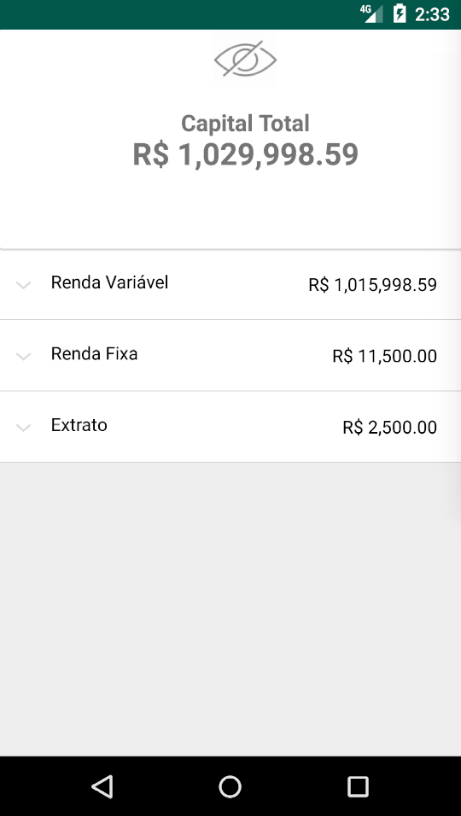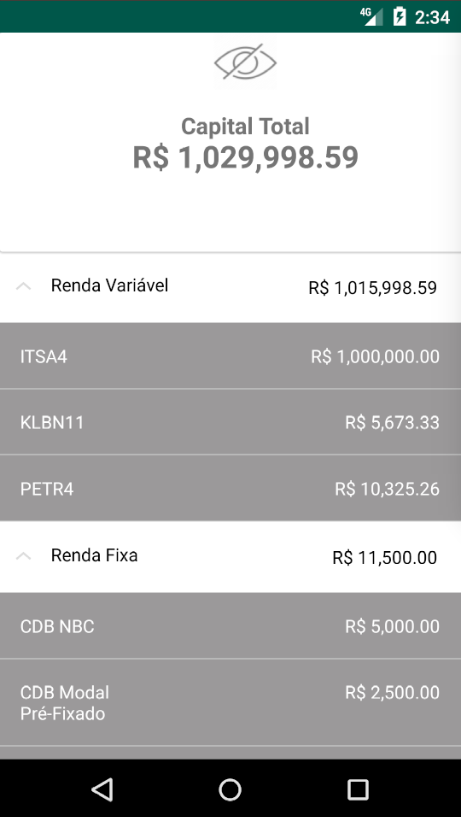Android: How to do an Expandable List View with groups and subgroups
Currently I’m working in a personal project using Android, my objective is to create an app which gathers all the information from user bank accounts or investment brokers in one place, to be easier to manage the money.
So I need to use Expandable List View to list each “source” of money. The final result and the tutorial you can see below.
The values shown are fictitious
Expandable List closed

Expandable List opened

Let’s Get Started
After you create your project and the mainActivity, you can start by the main layout (/res/layout/list_layout.xml):
<?xml version="1.0" encoding="utf-8"?>
<LinearLayout xmlns:android="http://schemas.android.com/apk/res/android"
android:layout_width="match_parent"
android:layout_height="match_parent">
<ExpandableListView
android:id="@+id/elvInvestments"
android:layout_width="match_parent"
android:layout_height="match_parent"
android:layout_margin="8dp" />
</LinearLayout>
Main item layout (group) (/res/layout/list_group.xml)

<?xml version="1.0" encoding="utf-8"?>
<LinearLayout xmlns:android="http://schemas.android.com/apk/res/android"
android:layout_width="match_parent"
android:layout_height="wrap_content"
android:background="#ffffffff"
android:orientation="horizontal">
<TextView
android:id="@+id/tvGroup"
android:layout_width="0dp"
android:layout_height="wrap_content"
android:layout_marginBottom="16dp"
android:layout_marginLeft="40dp"
android:layout_marginRight="16dp"
android:layout_marginTop="16dp"
android:layout_weight="8"
android:text="Group"
android:textColor="@android:color/black"/>
<TextView
android:id="@+id/tvAmount"
android:layout_width="0dp"
android:layout_height="wrap_content"
android:layout_margin="18dp"
android:layout_weight="12"
android:gravity="right"
android:text="Amount"
android:textColor="@android:color/black"/>
</LinearLayout>
Subitem layout (group item) (/res/layout/list_item_group.xml):

<?xml version="1.0" encoding="utf-8"?>
<LinearLayout xmlns:android="http://schemas.android.com/apk/res/android"
android:layout_width="match_parent"
android:layout_height="wrap_content"
android:background="#ff9b999a"
android:orientation="horizontal">
<TextView
android:id="@+id/tvItem"
android:layout_width="0dp"
android:layout_height="wrap_content"
android:layout_margin="16dp"
android:layout_weight="7"
android:text="Item"
android:textColor="@android:color/white"/>
<TextView
android:id="@+id/tvRealAmount"
android:layout_width="0dp"
android:layout_height="wrap_content"
android:layout_margin="16dp"
android:layout_weight="16"
android:gravity="right"
android:text="Amount"
android:textColor="@android:color/white"/>
</LinearLayout>
Since we are doing a custom ExpandableListView, we can change colors, fonts and sizes to fit as we want.
For the information to be displayed in the ExpandableListView, we have to create an adapter, in this case a BaseExpandableListAdapter and implement the necessary methods as below:
package com.distribution.fsrsolutions.nino;
import android.content.Context;
import android.view.LayoutInflater;
import android.view.View;
import android.view.ViewGroup;
import android.widget.BaseExpandableListAdapter;
import android.widget.TextView;
import java.util.HashMap;
import java.util.List;
public class ListViewAdapter extends BaseExpandableListAdapter {
private List<String> lstGroups;
private HashMap<String, List<Investment>> lstItemsGroups;
private Context context;
public ListViewAdapter(Context context, List<String> groups, HashMap<String, List<Investment>> itemsGroups){
// initialize class variables
this.context = context;
lstGroups = groups;
lstItemsGroups = itemsGroups;
}
@Override
public int getGroupCount() {
// returns groups count
return lstGroups.size();
}
@Override
public int getChildrenCount(int groupPosition) {
// returns items count of a group
return lstItemsGroups.get(getGroup(groupPosition)).size();
}
@Override
public Object getGroup(int groupPosition) {
// returns a group
return lstGroups.get(groupPosition);
}
@Override
public Object getChild(int groupPosition, int childPosition) {
// returns a group item
return lstItemsGroups.get(getGroup(groupPosition)).get(childPosition);
}
@Override
public long getGroupId(int groupPosition) {
// return the group id
return groupPosition;
}
@Override
public long getChildId(int groupPosition, int childPosition) {
// returns the item id of group
return childPosition;
}
@Override
public boolean hasStableIds() {
// returns if the ids are specific ( unique for each group or item)
// or relatives
return false;
}
@Override
public View getGroupView(int groupPosition, boolean isExpanded, View convertView, ViewGroup parent) {
// create main items (groups)
if(convertView == null){
LayoutInflater layoutInflater = (LayoutInflater) context.getSystemService(Context.LAYOUT_INFLATER_SERVICE);
convertView = layoutInflater.inflate(R.layout.list_group, null);
}
TextView tvGroup = (TextView) convertView.findViewById(R.id.tvGroup);
TextView tvAmount = (TextView) convertView.findViewById(R.id.tvAmount);
tvGroup.setText((String) getGroup(groupPosition));
tvAmount.setText(String.valueOf(getChildrenAmount(groupPosition)));
return convertView;
}
@Override
public View getChildView(int groupPosition, int childPosition, boolean isLastChild, View convertView, ViewGroup parent) {
// create the subitems (items of groups)
if(convertView == null) {
LayoutInflater layoutInflater = (LayoutInflater) context.getSystemService(Context.LAYOUT_INFLATER_SERVICE);
convertView = layoutInflater.inflate(R.layout.list_item_group, null);
}
TextView tvItem = (TextView) convertView.findViewById(R.id.tvItem);
TextView tvRealAmount = (TextView)convertView.findViewById(R.id.tvRealAmount);
Investment investment = (Investment) getChild(groupPosition, childPosition);
tvItem.setText(investment.getName());
tvRealAmount.setText(investment.getStringAmount());
return convertView;
}
@Override
public boolean isChildSelectable(int groupPosition, int childPosition) {
// returns if the subitem (item of group) can be selected
return true;
}
As my example deals with investments, I have created the Investment class:
package com.distribution.fsrsolutions.nino;
public class Investment {
private String name;
private int quantity;
private double amount;
public Investment(String name, int quantity, double amount){
this.name = name;
this.quantity = quantity;
this.amount = amount;
}
public void setName(String name){
this.name = name;
}
public String getName(){
return name;
}
public void setQuantity(int quantity){
this.quantity = quantity;
}
public int getQuantity(){
return quantity;
}
public void setAmount(double amount){
this.amount = amount;
}
public double getAmount(){
return amount;
}
public String getStringAmount(){
return String.format("R$ %,.2f", amount);
}
}
To finalize, go to our Activity, we created the data and defined our adapter:
package com.distribution.fsrsolutions.nino;
import android.support.v7.app.AppCompatActivity;
import android.os.Bundle;
import android.view.View;
import android.widget.ExpandableListView;
import android.widget.ImageButton;
import android.widget.TextView;
import java.util.ArrayList;
import java.util.HashMap;
import java.util.List;
public class MainActivity extends AppCompatActivity {
private Integer FLAG_HIDE_UNHIDE = 0;
private String totalAmount = "";
@Override
protected void onCreate(Bundle savedInstanceState) {
super.onCreate(savedInstanceState);
setContentView(R.layout.activity_main);
ExpandableListView elvInvestments = (ExpandableListView) findViewById(R.id.elvInvestments);
// Create the groups
final List<String> lstGroups = new ArrayList<>();
lstGroups.add("Renda Variavél");
lstGroups.add("Renda Fixa");
lstGroups.add("Extrato");
// Create items of each group
List<Investment> lstRendaVariavel = new ArrayList<>();
lstRendaVariavel.add(new Investment("ITSA4", 100, 1000000.00));
lstRendaVariavel.add(new Investment("KLBN11", 500, 5673.33));
lstRendaVariavel.add(new Investment("PETR4", 1000, 10325.26));
List<Investment> lstRendaFixa = new ArrayList<>();
lstRendaFixa.add(new Investment("CDB NBC", 0, 5000.00));
lstRendaFixa.add(new Investment("CDB Modal Pré-Fixado", 0, 2500.00));
lstRendaFixa.add(new Investment("LCA Indusval", 0, 4000.00));
List<Investment> lstExtrato = new ArrayList<>();
lstExtrato.add(new Investment("Transferência AG000/CC0000-0", 0, 2500.00));
// Create the relationship of groups and your items
final HashMap<String, List<Investment>> lstItemsGroup = new HashMap<>();
lstItemsGroup.put(lstGroups.get(0), lstRendaVariavel);
lstItemsGroup.put(lstGroups.get(1), lstRendaFixa);
lstItemsGroup.put(lstGroups.get(2), lstExtrato);
// Create an adapter (BaseExpandableListAdapter) with the data above
final ListViewAdapter listViewAdapter = new ListViewAdapter(this, lstGroups, lstItemsGroup);
// defines the ExpandableListView adapter
elvInvestments.setAdapter(listViewAdapter);
}
}
The final result you can see below.

References ExpandableListView Tutorial.

